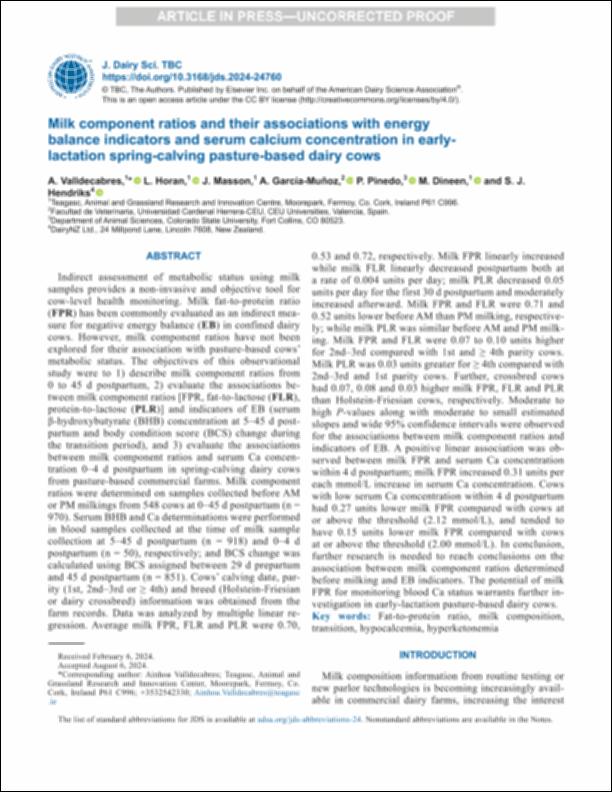Por favor, use este identificador para citar o enlazar este ítem:
http://hdl.handle.net/10637/16308Milk component ratios and their associations with energy balance indicators and serum calcium concentration in early-lactation spring-calving pasture-based dairy cows
| Título : | Milk component ratios and their associations with energy balance indicators and serum calcium concentration in early-lactation spring-calving pasture-based dairy cows |
| Autor : | Valldecabres Inchaustegui, Ainhoa Horan, L. Masson, J. García Muñoz, Ángel Pinedo, P. Dineen, M. Hendriks, S.J. |
| Materias: | Vaca lechera; Dairy cow; Leche; Milk; Calcio; Calcium |
| Editorial : | Elsevier American Dairy Science Association |
| Citación : | Valldecabres, A., Horan, L., Masson, J., García-Muñoz, A., Pinedo, P., Dineen, M., & Hendriks, S.J. (2024). Milk component ratios and their associations with energy balance indicators and serum calcium concentration in early-lactation spring-calving pasture-based dairy cows. Journal of Dairy Science. Advance online publication (07 sep.). https://doi.org/10.3168/jds.2024-24760 |
| Resumen : | Indirect assessment of metabolic status using milk samples provides a non-invasive and objective tool for cow-level health monitoring. Milk fat-to-protein ratio (FPR) has been commonly evaluated as an indirect measure for negative energy balance (EB) in confined dairy cows. However, milk component ratios have not been explored for their association with pasture-based cows' metabolic status. The objectives of this observational study were to 1) describe milk component ratios from 0 to 45 d postpartum, 2) evaluate the associations between milk component ratios [FPR, fat-to-lactose (FLR), protein-to-lactose (PLR)] and indicators of EB (serum β-hydroxybutyrate (BHB) concentration at 5–45 d postpartum and body condition score (BCS) change during the transition period), and 3) evaluate the associations between milk component ratios and serum Ca concentration 0–4 d postpartum in spring-calving dairy cows from pasture-based commercial farms. Milk component ratios were determined on samples collected before AM or PM milkings from 548 cows at 0–45 d postpartum (n = 970). Serum BHB and Ca determinations were performed in blood samples collected at the time of milk sample collection at 5–45 d postpartum (n = 918) and 0–4 d postpartum (n = 50), respectively; and BCS change was calculated using BCS assigned between 29 d prepartum and 45 d postpartum (n = 851). Cows' calving date, parity (1st, 2nd–3rd or ≥ 4th) and breed (Holstein-Friesian or dairy crossbred) information was obtained from the farm records. Data was analyzed by multiple linear regression. Average milk FPR, FLR and PLR were 0.70, 0.53 and 0.72, respectively. Milk FPR linearly increased while milk FLR linearly decreased postpartum both at a rate of 0.004 units per day; milk PLR decreased 0.05 units per day for the first 30 d postpartum and moderately increased afterward. Milk FPR and FLR were 0.71 and 0.52 units lower before AM than PM milking, respectively; while milk PLR was similar before AM and PM milking. Milk FPR and FLR were 0.07 to 0.10 units higher for 2nd–3rd compared with 1st and ≥ 4th parity cows. Milk PLR was 0.03 units greater for ≥ 4th compared with 2nd–3rd and 1st parity cows. Further, crossbred cows had 0.07, 0.08 and 0.03 higher milk FPR, FLR and PLR than Holstein-Friesian cows, respectively. Moderate to high P-values along with moderate to small estimated slopes and wide 95% confidence intervals were observed for the associations between milk component ratios and indicators of EB. A positive linear association was observed between milk FPR and serum Ca concentration within 4 d postpartum; milk FPR increased 0.31 units per each mmol/L increase in serum Ca concentration. Cows with low serum Ca concentration within 4 d postpartum had 0.27 units lower milk FPR compared with cows at or above the threshold (2.12 mmol/L), and tended to have 0.15 units lower milk FPR compared with cows at or above the threshold (2.00 mmol/L). In conclusion, further research is needed to reach conclusions on the association between milk component ratios determined before milking and EB indicators. The potential of milk FPR for monitoring blood Ca status warrants further investigation in early-lactation pasture-based dairy cows. |
| Descripción : | Este es el post-print del siguiente artículo: Valldecabres, A., Horan, L., Masson, J., García-Muñoz, A., Pinedo, P., Dineen, M., & Hendriks, S.J. (2024). Milk component ratios and their associations with energy balance indicators and serum calcium concentration in early-lactation spring-calving pasture-based dairy cows. Journal of Dairy Science. Advance online publication (07 sep.), que se ha publicado de forma definitiva en: https://doi.org/10.3168/jds.2024-24760 This is the peer reviewed version of the following article: Valldecabres, A., Horan, L., Masson, J., García-Muñoz, A., Pinedo, P., Dineen, M., & Hendriks, S.J. (2024). Milk component ratios and their associations with energy balance indicators and serum calcium concentration in early-lactation spring-calving pasture-based dairy cows. Journal of Dairy Science. Advance online publication (07 sep.), which has been published in final form at https://doi.org/10.3168/jds.2024-24760 |
| URI : | http://hdl.handle.net/10637/16308 |
| Derechos: | http://creativecommons.org/licenses/by/4.0/deed.es Open Access |
| ISSN : | 0022-0302 1525-3198 (Electrónico) |
| Fecha de publicación : | 7-sep-2024 |
| Centro : | Universidad Cardenal Herrera-CEU |
| Aparece en las colecciones: | Dpto. Producción y Sanidad Animal, Salud Pública Veterinaria y Ciencia y Tecnología de los Alimentos |
Los ítems de DSpace están protegidos por copyright, con todos los derechos reservados, a menos que se indique lo contrario.


